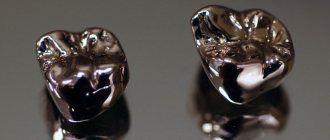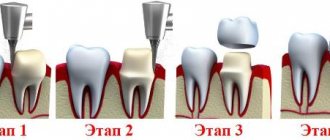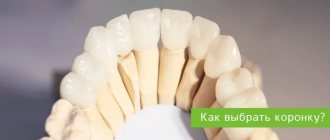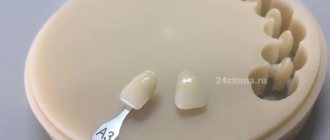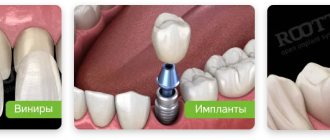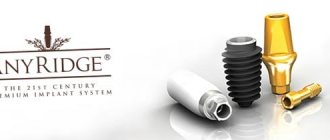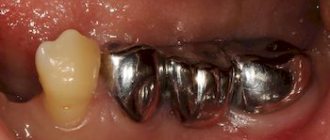- Dental crown - what is it?
- Types, materials, manufacturing methods and photos of dental crowns
- Time and stages of making dental crowns
- Lifespan of dental crowns
- How to best prepare for a visit to an orthopedic dentist
- Before visiting an orthopedic dentist
- At the dentist's appointment
- After prosthetics
- Which crown is better - metal-ceramic or zirconium?
- Common questions from clients
- About cheap dental crowns, advice
Dental crown - what is it?
A dental crown is a structure that replaces or restores the coronal part of a tooth.
By analogy, the crown can be compared to a soldier’s helmet. A crown on a tooth covers its upper part, like a helmet, on a soldier's head. A dental crown has three main functions:
- Aesthetic (visually retains an appearance indistinguishable from your own teeth)
- Functional (promotes chewing, as it is fully capable of withstanding and distributing the chewing load in full.)
- Protective (preserves the tooth’s own tissues from mechanical and carious damage)
Why do you need to cover (restore) teeth with crowns?
- Tooth decay is the most common reason for crowning. If the coronal part of the tooth is destroyed by more than 50% or the presence of circular caries, restoration of the coronal part of the tooth with an orthopedic crown is indicated. If this rule is not followed, unfortunately, within several years the tooth is destroyed and further restoration is not possible (the tooth will be removed).
- Depulped (nerves have been removed from the teeth) chewing teeth should be covered with orthopedic crowns to avoid chips and fractures of the walls of the crown part of the tooth. The thing is that when depulping (removing the nerve of a tooth), in addition to the nerve, the entire nutrient bundle is removed. In other words, the tooth does not receive nutrition and the materials used to fill the root canal have a strong drying effect on the tooth tissue, that is, they dry out the tooth, and therefore the tooth becomes very fragile.
- Aesthetic defects, such as dental discoloration due to fluorosis, enamel hypoplasia, tetracycline teeth, etc., require restoration through the manufacture of crowns.
- Injuries, in case of traumatic damage to the coronal part of the tooth (fracture, chipped tooth crown), there is often a need for restoration with an orthopedic crown.
- The need for total or partial jaw prosthetics. That is, if it is necessary to replace part of the missing teeth or correct dentofacial deformations, the supporting teeth are covered with crowns, which are part of bridge or splinting prostheses.
- Also, if we are talking about removable dentures, then the supporting teeth are covered with crowns to avoid mechanical damage from excess pressure from the removable denture.
Why depulpate teeth before dentures?
Before prosthetics, the dentist must grind (remove part of the dentin and enamel) the tooth by 1.5 - 2 mm (depending on the material of the future crown) around the circumference. It is impossible to maintain absolute sterility during this process, due to the fact that the oral cavity is not sterile. Therefore, by leaving your teeth “alive” you preserve microbes in your tooth, and over time (from several months to several years) the problem will make itself known and the tooth will have to be removed.
The indications for the use of these structures are the broadest:
Indications for the use of crowns
- Defects of the natural crown are more than half its size;
- Increased (inappropriate for age) abrasion of teeth; correction of jaw relationship (bite);
- Deep wedge-shaped defects are areas of triangular-shaped loss of hard tissue in the neck of the tooth (near the gums), weakening it and increasing the risk of complete breakage during chewing;
- Congenital anomaly of tooth shape (for example, underdevelopment or complete absence of enamel) or acquired (for example, after injury);
- Some congenital or acquired pronounced color changes that cannot be eliminated by bleaching (discolorities) are the consequences of injuries, medications used or materials for filling root canals;
- Tilting and/or protrusion of a tooth or a group of them when the patient refuses orthodontic treatment (orthopedic “movement”);
- Combining - splinting - teeth when they are mobile (the crowns are not made separately, but as a single block and are fixed at the same time);
- The need to improve the shape and protection of the tooth during removable prosthetics (creating pronounced convex contours that will hold the fixing elements and, along with them, the prosthesis itself);
- The presence of aesthetically unsatisfactory crowns (all-metal, combined with chips of the facing material or a gray-blue border, visible at the gingival margin when it decreases or thins).
Despite the variety of clinical situations in which the use of these structures is justified, the general rule is prosthetics in the early stages.
Types, materials, manufacturing methods and photos of dental crowns:
In modern dentistry, metal-ceramic crowns and crowns based on zirconium dioxide are most often used.
Crowns such as solid-cast and stamped are made extremely rarely and mainly in cases where it is impossible or impractical to manufacture metal-ceramic or zirconium crowns.
- Metal-ceramic crowns
They are a combined crown, where the frame (cap) is made of metal, which is later covered with ceramic mass. Aesthetically and functionally, it is practically no different from your own dental tissues. - Crowns based on zirconium dioxide (zirconium)
They are a combined crown, where the frame (cap) is made of zirconium (in other words, a white mineral) which is later covered with ceramic mass. Aesthetically and functionally, it is practically no different from your own dental tissues. Zirconium crowns are more aesthetic due to increased transparency. - Temporary crowns (metal-plastic crowns)
They are made of either composite or plastic. These crowns are slightly inferior in beauty and strength to the above. But they have a huge advantage - they can be made in a matter of minutes right in the dentist’s office. They are used as an intermediate (protective) structure during the production of permanent crowns.
What are they: materials
Crowns can be made from a wide range of materials. Some of them contain a metal base, others are completely synthetic. The choice of material depends on the purpose of the crown, wearing time, wishes for appearance and financial capabilities of the patient.
Metal ceramics
Crown with a metal frame and ceramic coating. The material is reliable and aesthetically pleasing. But there are several contraindications to metal-ceramic dental crowns:
- gum recession - the denture becomes visible;
- age under 18 years - thin enamel in children, which is why there is a risk of injury to the pulp when grinding the tooth.
For the adult population, metal-ceramic crowns are considered an excellent option for correcting dentition.
Metal composite
The product has a frame made of an alloy of cobalt and chromium, and a photopolymer composite is used for cladding. The crown is formed in a soft state and then hardens under the light of an ultraviolet lamp.
The result is a thin and durable coating. But the photopolymer composite is colored by bright pigments in food and drinks, so the patient will have to limit himself in consuming such products.
Golden
The material, tested by time and many patients, is gold. It is a precious metal, so it is hypoallergenic. Such products are perfect for people with high sensitivity to foreign materials.
Gold is a soft metal, which is why crowns quickly wear out under the pressure of antagonists. But they do not spoil the enamel of healthy teeth.
Zirconium dioxide
The most modern material for making crowns is zirconium dioxide.
| pros | Minuses |
| High strength; | High price. |
| Aesthetics; | |
| Hypoallergenic; | |
| Long service life. |
In terms of the ratio of advantages and disadvantages, this material is the most optimal of all possible. But the high price is not for everyone.
Metal-free
Modern techniques for making crowns make it possible to avoid metals in the composition of the product. This is especially important for those who are allergic to them, and you don’t want to lose aesthetics by installing a gold model.
Ceramic
Ceramic crowns are the most similar to natural teeth. They have a sufficient degree of transparency, and can also be matched in color to match natural enamel.
But such crowns are fragile and fragile. Therefore, they are used for the front teeth, and for the back teeth you will have to choose a different material.
Porcelain
Porcelain crowns are not as popular, but they have many advantages.
| pros | Minuses |
| Anatomical shape; | Fragility; |
| High accuracy; | High price; |
| Comfortable wear; | Loose fit; |
| Strong fixation; | High risk of destruction of adjacent teeth. |
| Minimal risk of loosening; | |
| High aesthetics; | |
| Durability; | |
| No staining; | |
| Resistance to temperature changes; | |
| Hypoallergenic. |
In terms of the ratio of pros and cons, porcelain products win in many respects. But people with thin enamel are not recommended to have them installed due to the risk of damaging healthy teeth.
Combined
Models made from combined materials are suitable for long-term wear. They can be used for teeth with any location: they are aesthetically pleasing for the front ones and can withstand the load of the back ones.
Such products are not without drawbacks. They quickly wear out and wear out, and can become deformed. But this is a fairly budget option for prosthetics.
Plastic
The products are only suitable as a temporary tooth replacement. They are light and comfortable, their production takes little time and does not require a large budget. While the permanent structure is being prepared, you can use plastic crowns, but you won’t be able to wear them for a long time - they simply won’t withstand the load.
Time and stages of making dental crowns
To make permanent dental crowns, the dentist will require an average of a week and 2-3 patient visits.
- First visit The doctor conducts a functional analysis. Then the teeth are prepared (depending on the type of dental crown). Takes silicone impressions. Makes and fixes temporary crowns on prepared teeth. Determines the color of future teeth together with the patient. Discusses options for crown shapes.
- Second visit (after 7 days) Trying on the finished structure in the oral cavity. Fixation of the crown with double-hardening cement. If the shape or color needs to be adjusted, another visit to the dentist may be required. Metal-ceramic and zirconium crowns are made in a dental laboratory within 7-12 days (depending on the complexity of the work). More than 5 dental technicians are involved in the process.
We strongly do not recommend using advertising products “dental crowns in an hour”, etc.
Unfortunately, technically, modern CAD CAM systems do not reach the level that a dental technician can make (either aesthetically or functionally) the marginal fit of such crowns, and the aesthetic appearance does not stand up to criticism.
Before visiting an orthopedic dentist
- Do not be nervous.
- Before taking (an hour), eat a hearty meal (the process of digesting food reduces strong emotional arousal).
- Try to plan your first visit to an orthopedic dentist for the first half of the day while it is light (only natural light allows you to accurately determine the color of your teeth), before the doctor is tired (we are all human, and in the first half of the day the doctor will pay you more attention and time than in the evening), while you not tired (the patient’s understanding of the process and all stages of treatment is very important).
- Collect all the photographs of your teeth that were taken before (regardless of the statute of limitations), this is often necessary.
- If you have old dental crowns or dentures, you should also take them with you.
At the dentist's appointment
- Try to listen carefully to the dentist about possible prosthetic options. Do not hesitate to ask questions (your understanding of the treatment process is very important).
- Make a decision on one or another prosthetic option. Ask about the timing and total cost of treatment. Ask for a detailed treatment plan indicating the full cost, payment schedules and treatment time frames.
- Check the warranty period. Read the contracts carefully. If something worries you or you have doubts, do not hesitate to take a time out.
Remember! It is better to consult several doctors before starting anything.
Avoid! Promises and bravado, if you have previously consulted with several doctors and only one promised you what others refused, then we advise you to contact those who refused.
Carefully! If the clinic lures you into paying the full amount of treatment immediately REMEMBER that you will not get it back. Try to avoid clinics with this approach to taking money despite the discounts offered.
After prosthetics
- Before prosthetics, finally check the color and shape of the dental crowns in natural light. It’s better to go out into the hall and look in a regular mirror.
- Once fixed, it will be impossible to change the color.
- After fixing the crowns, try to spend some time in the clinic (for example, in the lobby), once again checking the structures in a more relaxed atmosphere.
- Ask your doctor about hygiene and special care practices.
- Ask for the doctor’s contact number (if necessary, ask questions by phone).
- Make an appointment with your doctor in 7 days for a follow-up examination, regardless of the condition of the crowns.
- Professional control is required after 7 days.
- If you experience any problems with your crowns, contact your dentist immediately.
Contraindications
Not all patients can have crowns. Contraindications to the procedure:
- the last stage of periodontitis - the prosthesis may fall out due to weakened jaw tissue;
- enamel fragility - due to the risk of tooth decay;
- Bruxism - increased tone of the jaw muscles during stress or sleep;
- small height of the teeth and their incorrect position - the crown will not hold;
- pathological bite with incisal overlap - artificial crowns will wear out and destroy healthy teeth.
For some crown materials there are age restrictions for use. Therefore, only a doctor can choose the right prosthesis during a personal consultation.
Our advantages
At the OUR PEOPLE clinic, they value the health of their patients, so doctors install crowns only when indicated. If this method of prosthetics is not suitable, the dentist will select another correction method. An individual approach and attention to each patient is the key to high quality medical care at the SVOI PEOPLE clinic. Thanks to this, our clients wear dental crowns for many years.
Which crown is better - metal-ceramic or zirconium?
A bit of an incorrect question.
In terms of strength and aesthetic characteristics, these crowns are very close to each other.
On front teeth, zirconium crowns are more preferable due to their increased transparency.
But in the area of chewing teeth, we would not recommend using zirconium crowns due to the lower strength of the frame.
Therefore, the ideal option would be to use metal-ceramics in the area of the chewing teeth, and zirconium crowns in the area of the front teeth.
Content
- Indications for installation
- Types of crowns - which are better, comparison
- Which ones are suitable for chewing teeth?
- Which crowns are suitable for the smile area?
- Crowns on implants
- What do doctors advise?
- Comparison of costs of different types of crowns
- Preparing for installation
- Stages of crown installation
- Crown care
- How to choose a crown?
- Differences between a crown and a filling
- Service life of various crowns
Common questions from clients
why do the gums darken near the crown??
- Error when preparing a tooth for a crown.
- Error in the manufacture of the crown (non-certified metals or the frame overlaps the ceramics on the outer surface).
- Root caries (a carious process has occurred under the crown), that is, the seal of the crown is broken.
- In all cases, urgent replacement of the structure is required. Failure to follow the recommendation will result in tooth extraction.
why does the tooth under the crown turn black??
the tooth has turned black - this is a symptom of tooth tissue destruction and requires immediate treatment. The dentist will remove the crown and evaluate the condition of the tooth. If a small part of the tooth has darkened, you can fill the tooth and make a new crown.
Is it possible to redo zirconium crowns? ?
Can. For example, if the color of the crowns is radically different from their own. In this case, the crown is sawed and removed without damaging your tooth.
Most often, it is impossible to change the color of the crown without removing it. Unless we are talking about some completely insignificant defect, which can really be eliminated by slightly tinting the porcelain.
If the discrepancy is really serious and very noticeable, the crown will have to be removed and re-fired in a dental laboratory. This is undesirable as it may change the density of the porcelain. In addition, only a crown installed on temporary cement can be removed and put back - when removing a prosthesis installed on a permanent basis, it can become irreversibly deformed.
Is it possible to change the shape of a zirconium crown??
Some changes in shape can be made if the crown is installed with temporary cement.
The ceramic on the crown chipped, why?
- Bruxism (teeth grinding).
- Technical shortcomings in crown manufacturing.
- Incorrect determination of occlusion by the dentist.
- In all cases, urgent replacement of the structure is required. It is impossible to repair high-quality ceramic crowns; replacement is required.
The crown fell out, how did that happen?
- Consultation with a dentist is required.
- If the crown falls out before a year after manufacture, most likely an error was made during prosthetics (subject to fixation with permanent cement).
- If many years have passed, then there are too many options, this requires immediate intervention from a specialist.
Double crown or two separately – which is better?
It is better to make a connected common denture for two teeth.
Why does the tooth under the crown hurt?
- In almost all cases, it indicates problems in the supporting tooth. Immediate consultation with a specialist (orthopedic dentist, therapist and surgeon) is required.

